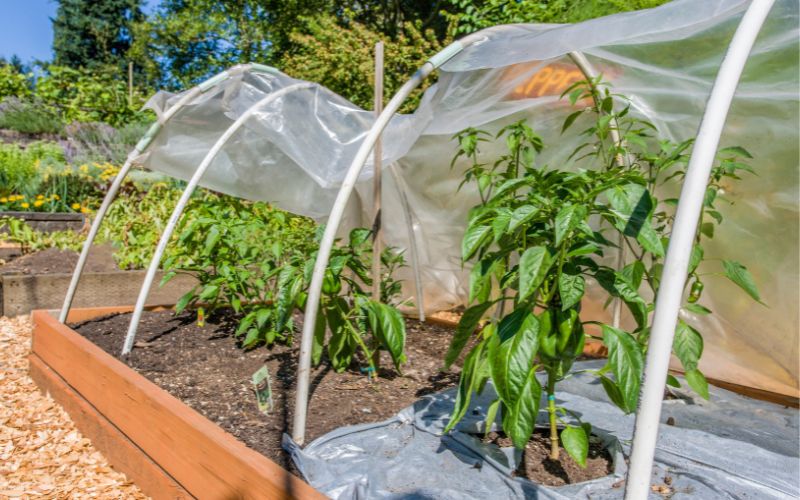
Gardening is a cherished pastime for many Canadians, offering a sense of accomplishment and a connection to nature. However, the joy of gardening can be marred by harsh weather conditions and pesky critters that threaten the health of your plants. A DIY PVC raised garden bed cover is an effective solution to these challenges. This guide will walk you through the process of creating one, using resources and materials easily accessible in Canada.
Benefits of a PVC Raised Garden Bed Cover
A DIY PVC raised garden bed cover offers a multitude of benefits.
Protection The cover shields your plants from pests and harsh weather conditions, including frost, heavy rain, and intense sun. This protection can help ensure the health and longevity of your plants.
Microclimate The cover creates a microclimate that can help your plants thrive. It can trap heat during the day, keeping your plants warm during cooler nights. It can also maintain humidity, which can be beneficial for many plants.
Cost-Effective Building a PVC raised garden bed cover is a cost-effective solution. The materials needed are relatively inexpensive, and the project can be completed without professional help.
Extended Growing Season The cover can extend your growing season by protecting plants from early frost in the fall and allowing you to plant earlier in the spring.
Versatility The cover is versatile and can be adapted to fit any size of raised bed. It can also be removed or adjusted as needed, providing flexibility in how you garden.
Materials Needed
PVC pipes (1/2-inch diameter, 10-foot lengths)
Brackets for attaching the PVC pipes
Clear plastic drop cloth or tarp
Hoophouse clips
Screws
2×4 wood sections for corner support
1×12 wood sections for raised bed construction
Tools: Screwdriver, saw, drill

Step-by-Step Guide
Step 1 Construct the Raised Bed
Start by building your raised garden bed using 1×12 wood sections. The size of the bed is up to you, but a common size is 4×8 feet. Use 2×4 sections to support the corners and ensure the bed is sturdy.
Step 2 Build the Hoop Frame
Next, construct the hoop frame using your PVC pipes. The hoops should be spaced evenly across the length of the bed. Attach the hoops to the bed using brackets. Ensure the hoops are secure and stable.
Step 3 Attach the Cover
Cover the hoop frame with a clear plastic drop cloth or tarp. This will protect your plants from harsh weather and pests. Secure the cover to the hoops using hoophouse clips. Make sure the cover is taut and secure.
Step 4 Secure the Cover
To prevent the cover from flapping in the wind, secure it further with rocks or weights at the ends. This will also help to keep the temperature inside the cover stable.
Step 5 Monitor and Adjust
Monitor your garden bed regularly to ensure the cover is working effectively. Adjust the cover as needed to allow for ventilation and to prevent overheating.
Additional Tips for Maintaining Your PVC Raised Garden Bed Cover
Pollination
Remember that some crops require pollination to produce a harvest. If these crops are still covered with fabric when they begin to flower, remove or temporarily lift fabric from the beds during the day to allow bees to do their work.
Insect Protection
Garden fabric will keep most insect pests away from your crops as long as plants are completely covered and the edges are securely pinned to the ground. They’ll block aphids, potato beetles, Japanese beetles, grasshoppers, leaf miners, cabbage worms, root maggots, and some vine borers. However, be vigilant as pest problems can still occur if insect eggs were laid before the fabric was applied, or insects emerge from the soil.

Temperature Management
As the weather warms up, check your plants to make sure they’re not overheating. This is especially important when it comes to cool-weather plants, such as lettuce and broccoli. Remove the cover if you see signs of overheating, such as wilting, leaf damage and/or blossom drop.
Reusability
Most covers will last one or two seasons, and some, such as GardenQuilt and Shade Netting, will last much longer. You can extend their life by keeping the edges pinned securely, and in windy areas, securing the fabrics tightly over hoops. When not in use, garden fabric should be folded and stored away from sun and moisture.
Repurposing
After they become worn, you can repurpose them in many ways. For instance, you can lay pieces of garden fabric over newly seeded lawns to prevent erosion of seed and soil, or place covers under bark mulch or soil to act as a weed barrier.
Conclusion
Building a DIY PVC raised garden bed cover is a practical and rewarding project for Canadian gardeners. It not only protects your plants but also extends the growing season, allowing you to enjoy your gardening hobby even more. So, gather your materials and get started on your DIY PVC raised garden bed cover today!
Remember, every garden is unique. Feel free to modify this guide to suit your specific needs and conditions. Happy gardening!
Colin Macmillan is a seasoned entrepreneur and the CEO of Riverwood Landscape, a leading landscaping company based in Canada. He has been at the helm of the company since leaving high school, demonstrating his strong leadership skills and business acumen.
Colin’s expertise lies in various aspects of landscaping, including lawn care, interlocking, sod installation, and commercial maintenance. His hands-on approach and dedication to the craft have been instrumental in building Riverwood Landscape into a reputable brand.
One of his most notable achievements is the creation of a successful landscape franchise that services multiple locations. This accomplishment underscores his strategic thinking and ability to scale operations effectively.
Colin has also had the privilege of working with Guelph Hospital for landscaping and maintenance, a testament to the trust and reliability that his company has earned over the years.
His professional mission is to offer the best services and experiences for customers, a goal that he tirelessly pursues. Colin’s commitment to excellence and customer satisfaction continues to drive the growth and success of Riverwood Landscape.








